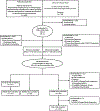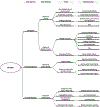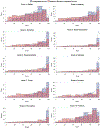Validation of bladder health scales and function indices for women's research
- PMID: 36596439
- PMCID: PMC10425263
- DOI: 10.1016/j.ajog.2022.12.319
Validation of bladder health scales and function indices for women's research
Abstract
Background: Existing bladder-specific measures lack the ability to assess the full range of bladder health, from poor to optimal health.
Objective: This study aimed to report evidence of validity of the self-administered, multidimensional bladder health scales and function indices for research in adult women.
Study design: A cross-sectional population-based validation study with random assignment to paper or electronic administration was conducted using national address-based probability sampling supplemented by purposive sampling of women with lower urinary tract symptoms in 7 clinical research centers. Construct validity of the bladder health scales and function indices was guided by a multitrait-multimethod approach using health and condition-specific questionnaires, bladder diaries, expert ratings of bladder health, and noninvasive bladder function testing. Internal dimensional validity was evaluated using factor analysis; internal reliability was assessed using paired t-tests and 2-way mixed-effects intraclass correlation coefficient models. Chi-square, Fisher exact, or t-tests were used for mode comparisons. Convergent validity was evaluated using Pearson correlations with the external construct measures, and known-group validity was established with comparison of women known and unknown to be symptomatic of urinary conditions.
Results: The sample included 1072 participants. Factor analysis identified 10 scales, with Cronbach's alpha ranging from 0.74 to 0.94. Intraclass correlation coefficients of scales ranged from 0.55 to 0.94. Convergent validity of the 10 scales and 6 indices ranged from 0.52 to 0.83. Known-group validity was confirmed for all scales and indices. Item distribution was similar by mode of administration.
Conclusion: The paper and electronic forms of the bladder health scales and function indices are reliable and valid measures of bladder health for use in women's health research.
Trial registration: ClinicalTrials.gov NCT04016298.
Keywords: adaptive behavior; construct validity; instrument; lower urinary tract symptoms; multitrait-multimethod.
Copyright © 2022 Elsevier Inc. All rights reserved.
Conflict of interest statement
The authors report no conflict of interest.
Figures



References
-
- Milsom I Lower urinary tract symptoms in women. Curr Opin Urol 2009;19:337–41. - PubMed
-
- Lee UJ, Feinstein L, Ward JB, et al. Prevalence of urinary incontinence among a nationally representative sample of women, 2005–2016: findings from the urologic diseases in America project. J Urol 2021;205:1718–24. - PubMed
-
- Gray TG, Vickers H, Krishnaswamy P, Jha S. A systematic review of English language patient-reported outcome measures for use in urogynaecology and female pelvic medicine. Int Urogynecol J 2021;32:2033–92. - PubMed
-
- Harlow BL, Bavendam TG, Palmer MH, et al. The Prevention of Lower Urinary Tract Symptoms (PLUS) Research Consortium: a transdisciplinary approach toward promoting bladder health and preventing lower urinary tract symptoms in women across the life course. J Womens Health (Larchmt) 2018;27:283–9. - PMC - PubMed

